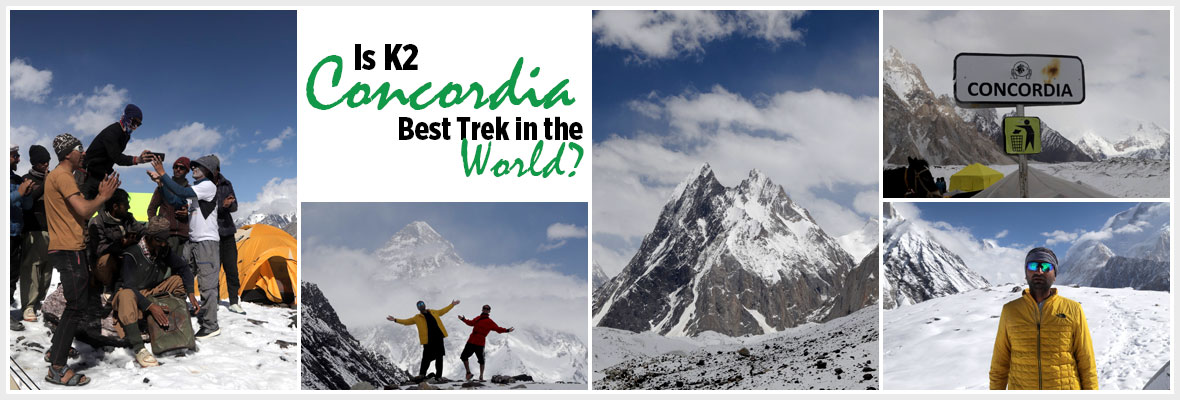
It was a windy night when the clock ticked 2 in the morning. There was the smell of dust while leaves were still damp after recent rainfall. Though it was July yet it felt more like blossom season. I grabbed my belongings and left home for the airport, where my companion Dr. Afsar Warraich had already arrived from Atlanta, USA.
Pakistani airports are such happening places where you would always find mixed emotions. Families are leaving the country for greener pastures – people are returning after decades – illegal immigrants are being taken by law enforcement. Dozens of people are welcoming people returning from Umrah and Ziarat. It’s such a lively place!
It was around 3 am when I welcomed Dr. Afsar, who looked fresh in the air for more than 21 hours. After the meet & greet, we went towards Islamabad for authentic tea. To our relief, the city slept while roads were devoid of traffic. We had Karak ( Strong) tea while we discussed our fast-approaching tour, as our flight to Skardu from Islamabad was scheduled at 6 am.
Table of Contents
We left after tea & reached Islamabad Airport in half an hour. On the way, the sky started to turn slightly gold before sunrise. Meanwhile, birds were chasing the sky. Here comes our first challenge; soon, we lined up in a queue to attain our boarding passes and learned that Dr. Afsar had lost his phone somewhere. We scanned our stuff to no avail.
The peril of losing a phone with access to your memories, contacts & finances was visible on Dr. Afsar’s face. I tried calming him down and sent my team to the same tea shop.
Those forty-five minutes before our flight were the most challenging. Sun started to rise & mercury ascended. At the same time, I had to leave the airport premises to bring the phone back. Eventually recovered it, got the phone, and boarded the flight on time. Upon reaching the phone, it felt almost like winning a trophy. So the nerves settled & Dr. Sab also felt relieved.
Just having a cup of tea and taking a few photos, we touched down in Skardu from 450 to 2500 meters in 55 minutes. Flight from Islamabad to Skardu is an adventurous ride on any given day. The pilot welcomes you in two languages while a kid cries while parents try to make them hush. Further, you witness many foreigners on Skardu-bound flights which is extremely rare on other flights.
Our pilot announced!
@widhussain360 visiting Baltistan yet again
“you can see Tarbeela dam on your left side” To be honest, the windows were so blurry that we could only make out where to locate any water. In the next few minutes, he continued.
“People sitting on the right can see Lake Saiful Malook, the most visited lake in Naran Valley. Soon we shall pass from Babusar Top & you might feel jitters as the weather is not too clear near Nanga Parbat.”
After such careful advice, we galloped our tea. We flew with little less turbulence than expected and landed safely at Skardu International Airport ( which is yet to be fully international). The weather was around 22 Celsius but felt more like 26 degree Celsius. Our civil aviation loves vintage vehicles, so they paraded us in antique buses, which debuted in the late 70s. Apparently, our authorities don’t love newer vehicles.
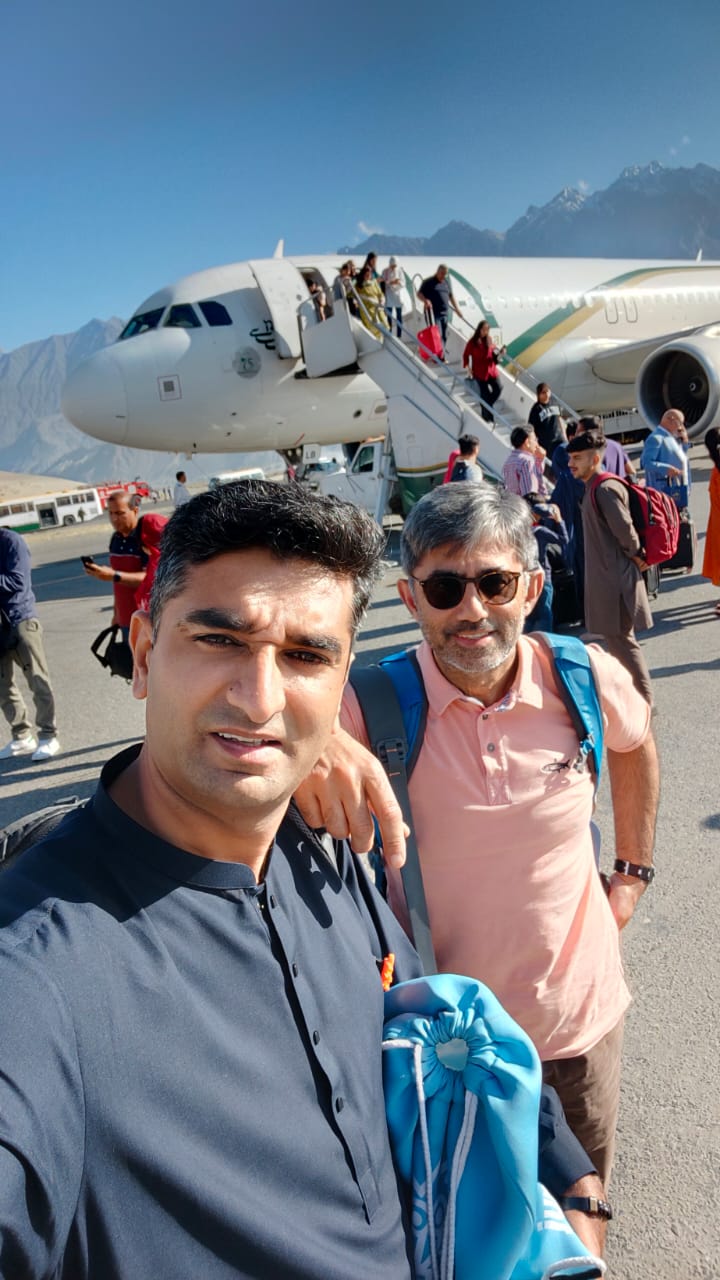
Arrival at Skardu Airport – Most Scenic Airport in the World
Our friend Mr. Ayaz Ahmed Shigri, who had promised to receive us from the airport, was late only by a fraction. We insisted on having some desi breakfast that was a bit freakish, yet he managed to gather some stuff for us, along with nice tea. While we were sitting in his Guest House, our eyes started to burn because of no sleep. Though Dr. Afsar was committed to staying awake to correct his sleeping cycle, he succeeded.
Next, we reached a nearby shop that the famous climber of Hushe owns, “Hassan Jan,” who has climbed all 8000-meter peaks in Pakistan. His son showed us various equipment. We purchased headlamps – safety & helmets. From there, we arrived at our outfitter’s house, “Ishaq,” who also belonged from Hushe & discussed our K2 Concordia trek.
We met our guide & crew there. However, for them, it was routine work. Big blue commercial drums were stuffed with fresh food, dry fruits, packed items, and more. We checked our satellite phone as it can be crucial in remote areas. We were supposed to take an electric generator at such high altitudes, and it needed to be fixed in Skardu, which concerned us big time.
We were carrying cameras that could only be recharged if we had a reliable generator, which was not working fine. Yet, we were assured that it would work. Anyways, after a bit of journey, we reached our hotel and crashed into beds to get some rest before the long journey the next day.
It was still dark when I got up & took a shower. Our bags were ready. Our guide showed up exactly 20 minutes late to our room. Further, Shyok River was calmly making its way in the morning. Our luggage was already loaded in the rear when we sat in our 92-model Toyota Parado. Due to early departure, we skipped our breakfast.
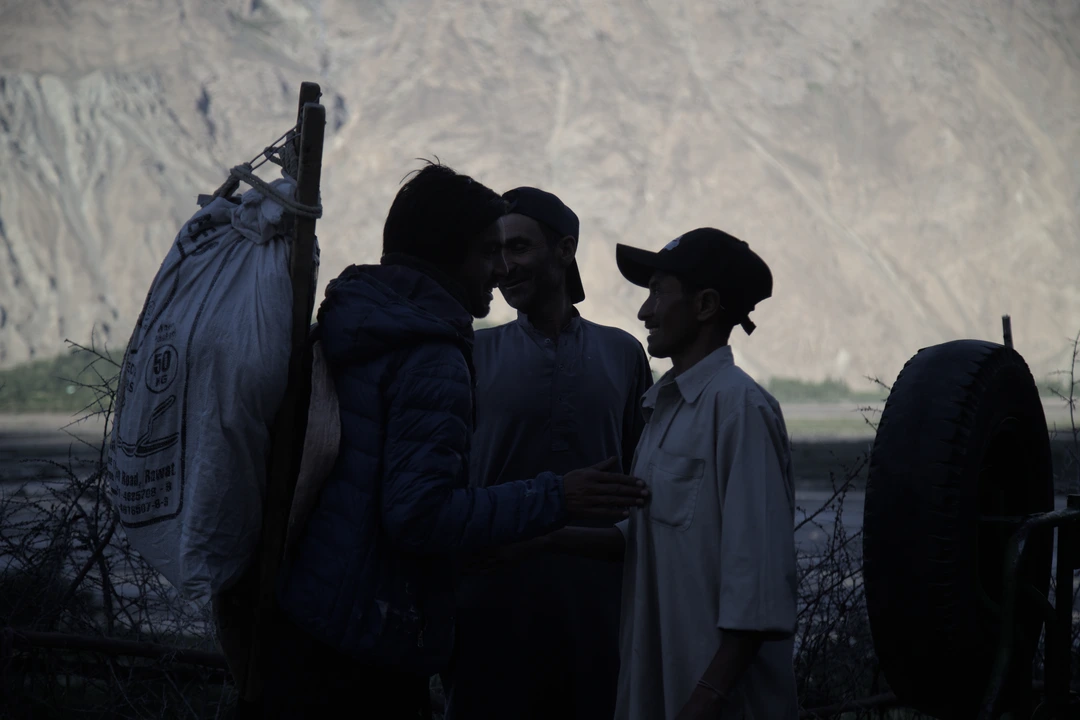
Porters meet up before K2 Basecamp trek 2023
After a while, the journey to Askoli started with lots of imagination & dreams. Our driver was driving the vehicle nothing short of a Formula One race. Our black Parado was rushing into Shigar town with an ever-changing landscape. The cool breeze was flowing while villagers were still asleep.
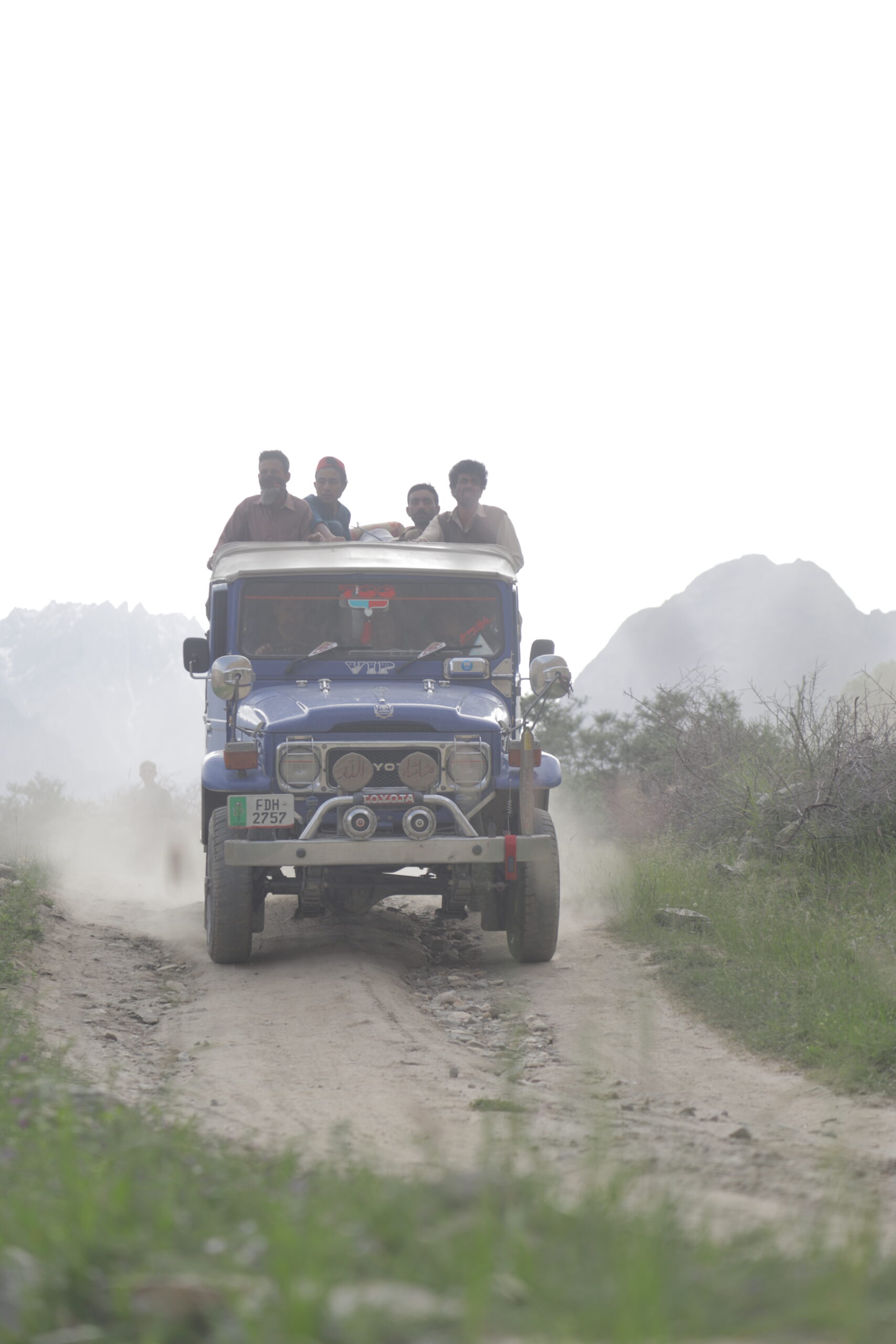
Jeep carrying our team & Luggage
We crossed two water streams that generally block the way during mid-day. That was the reason we started our journey before sunrise. Moreover, we saw various mulberry & apricot trees on the way. It was early July; apricots were still not fully ready in those remote valleys. The green color suggested that the apricots needed a bit more time.
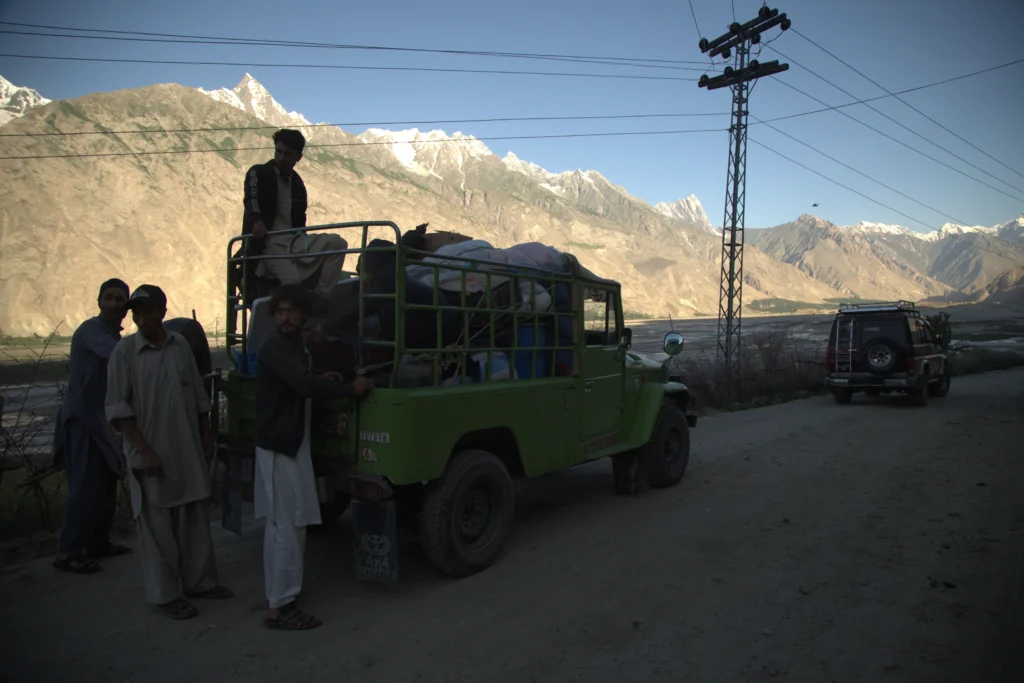
Jeeps from Skardu to Askoli Village
Finally, we arrived in Askoli after 05 hours. Interestingly, it felt more like a victory as the journey was stiff due to pathetic road conditions. Our porters started to unload. Camps were set up & kitchen staff was swift enough to erect a kitchen tent. Everything looks unreal.
There were various mountaineers at the campsite. It was the colorful bliss of multiple camps. People come to this last village of Northern Pakistan with big dreams. Some are successful & some end up with tragedies.
We took our lunch and tried to rest after a long journey. We made an effort to sneak into our camp, which was yellow & red. Leaving the comfort of your home to stay in a cramped camp is an adventure, and we were willing to test our limits.
In the evening, we had dinner. Mehdi was our master chef, along with Hussain as his aide. He had been scouting Karakoram for the last 25 years. He served us chicken & mix vegetable that was unarguably delicious. On the other hand, our porters were making dinner at their own pace. It was dark, so hard to know what exactly they were making.
We scampered to our camps. Porters were still murmuring over matters of mutual interest in the far distance. In those giggles, we slept with thousands of dreams. We started early after breakfast the following day: bread, egg, tea & fruit. It looked surreal in such remote lands. Further, Askari – the son of Mehdi, served us food. His shy smile was a treat to watch.
Askoli is a less populated village with around 200 households. Tourism is their lifeline. Women work in green fields that mostly grow potatoes & vegetables. Life is not easy here as it mostly remains cold throughout the year. Winters are extremely harsh in this region. Men mostly work as porters & contain a barrage of mules.
It was around 6 am when we left Askoli for Jhula camp. Walking on uneven pastures along gold-coated mountains, we arrived at Karafong. CKNP ( Central Karakoram National Park ) scrolled through our documents and briefed us on uphill tasks. The real journey began. The phone network would not work further from this region, so we made several calls.
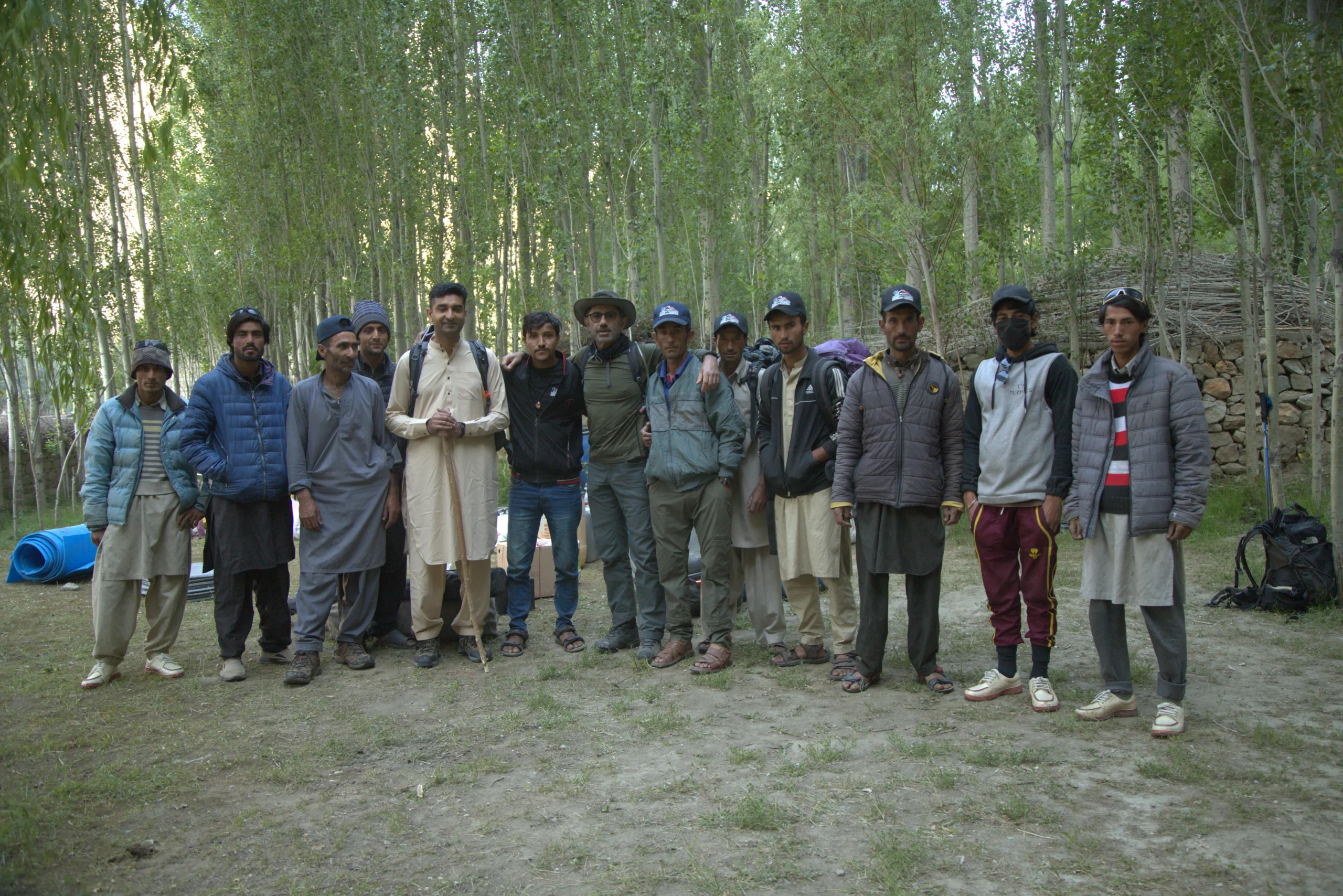
Our Team at Askoli before start of Trek – Left to Right Ansari ( Porter ), Hussain ( Porter ), Mehdi (Cheif Chef ), Ali Bhai ( Porter ) Ejaz Hussain ( Me ), Shahbaz ( Guide ), Dr. Afsar Warraich ( Leader of Tour ), Ali ( Mule head guy ), Hussain ( Assistant Chef ), Askari ( Son of Mehdi ), Tahir ( Head Porter )

Visiting CKNP Office Askoli Medane
We saw traffic of mules & porters. Each porter carries 25kg allocated weight for 10 to 12 hours daily here. On the other hand, mules have to sustain 75 kg on any given day. These poor souls have to face harsh environments and often receive injuries.
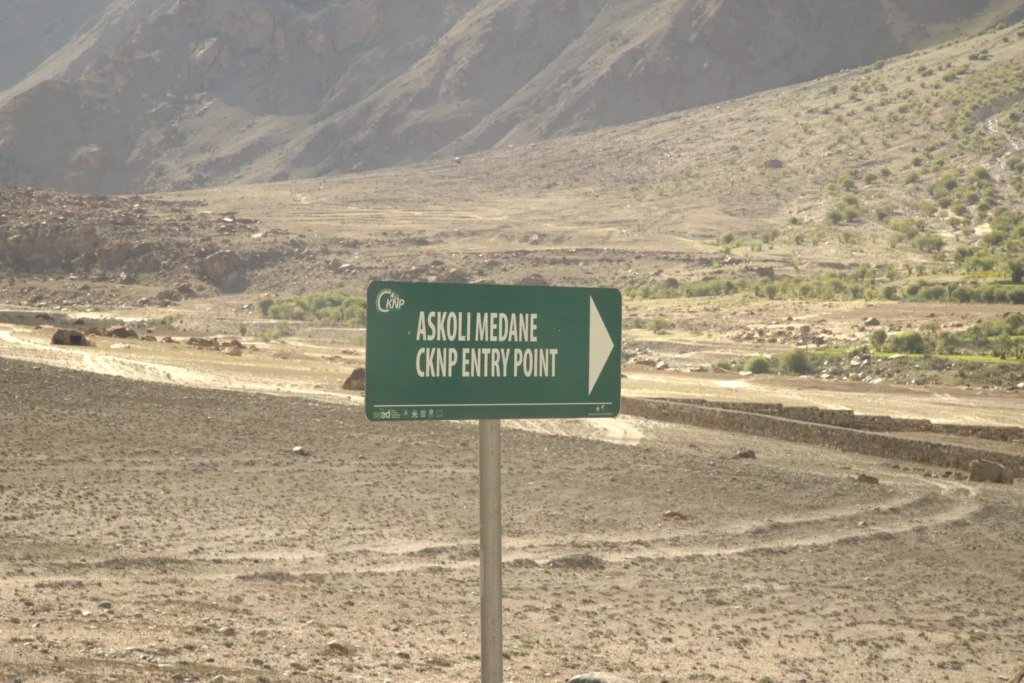
Askoli-medane
Here porters are most important. They make sure your luggage & food reach your camp before you. The face snow, rain, scorching sun & hustle of fellow porters. They make their food and mostly sleep in open tents. Their perils are unending. Once your feet are shivering due to the cold, they will still try to motivate you.
We motored along Jhula camp and arrived after 7 hours to Jhula. It was a lifeless camp side devoid of anything special. Yet, it was excellent as it was our first day of trekking in the mighty Karakoram. It was perfectly positioned near water & relatively wide as well. Here, we took dinner around 6 pm. Yet again, our chef did an amazing job providing us with freshly made soup, noodles & chicken karahi.
It’s worth mentioning that live chicken is carried and slaughtered daily during each trekking or mountaineering expedition. The same goes for sheep & lambs. We also saw a few yaks being taken to the k2 base camp. We noticed that Jhula camp had less hustle and bustle than we expected. Anyways, after a brief chit-chat, we resorted to our camps.
Around 4 am, Mehdi woke us up. Breakfast was already served. We made our way to toilets that were marginally in good shape in Pajju with running water. Though, the water was cold. The morning was cloudy with signs of rain. We rushed to the mess tent that provided us relief. Steaming hot tea, boiled eggs, bread & flakes welcomed us.
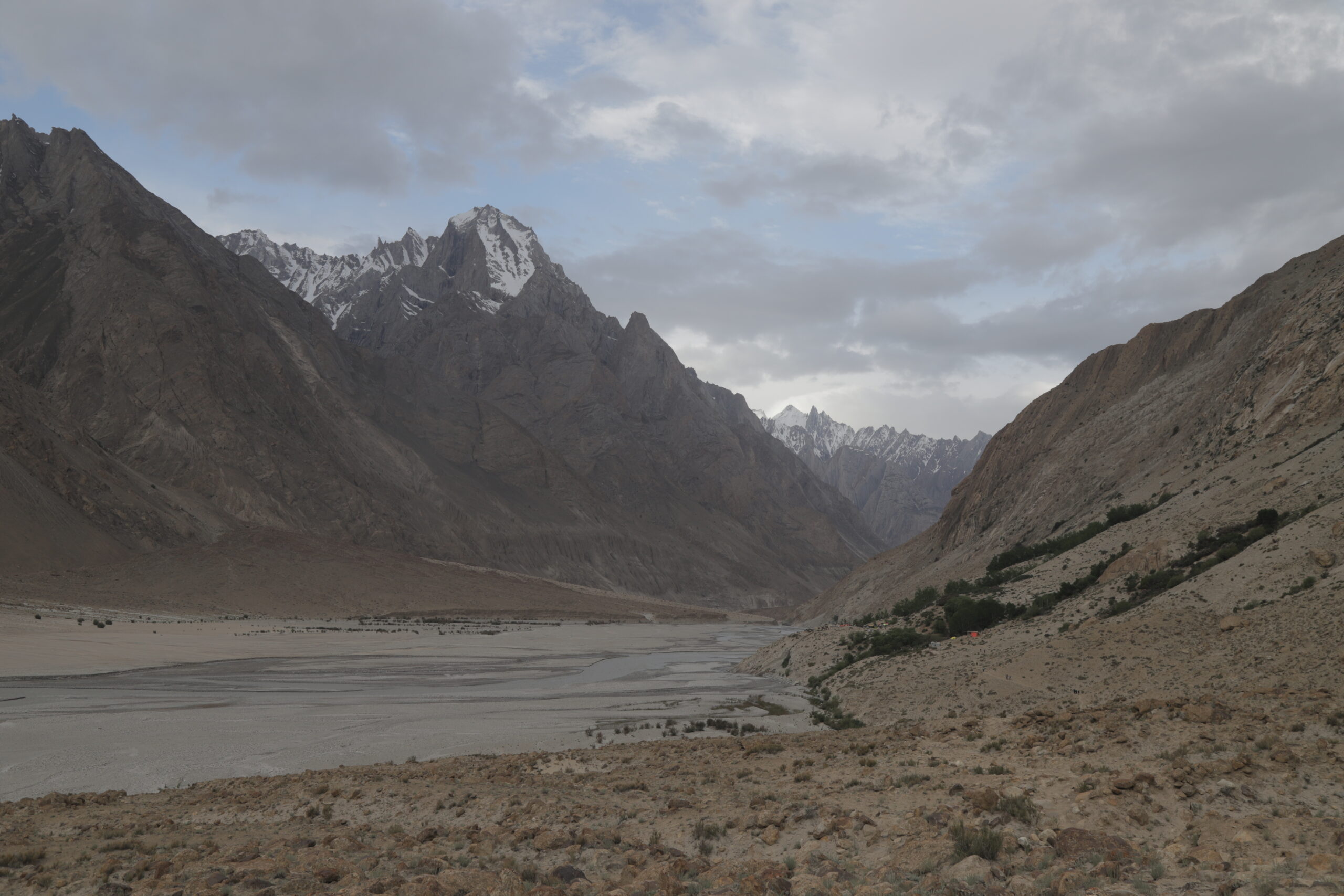
Paju campsite from Far Distance along Braldu River
We hurried trekking from Jhula to Pajju while the team disassembled our camps. The trek from Jhula to Pajju is around 20km. We were ready to test our limits. Our guide showed us the way. An initial couple of hours were fairly easy along the braided river.
While the real challenge was keeping pace with our team, as local porters were swift in their approach and vanished like ghosts in just a few minutes, they were incredible people. Sometimes they carry more than 25kg of luggage as well.
Light rain started when the clock ticked 11 in the noon. It was passing drizzle, fortunately, but the weather remained windy. Such weather was a blessing in disguise, as our team told us that if it had been a hot sunny day, it would have been tough to trek in the scorching heat. That was true, as we experienced fairly hot weather while returning from Concordia on the same route.
We took lunch on the way, including noodles and tea. We sat on a mat sheet while Porters rested on the ground. Once again, they reached at least a couple of hours before us. That showed their agility and stamina. They walked 13 km like it was nothing while we were hampering.
After half an hour, we started moving forward. The terrain was sandy with occasional bushes. The landscape was interesting. The trek was mostly along the river, but on several occasions, we also ascended the mountain. We were gaining elevation gradually. Finally, we arrived at Pajju, where our team greeted us with mountain tea.
Pajju was happening campsite. We saw lots of mountaineers there. It looked like a campsite with more than 200 tourists buzzing around. Various guides were moving along, and there was an endless supply of porters & mules every passing minute.
Reaching the restroom after trekking 20 km that day took a lot of work. Pajju is at a 3400-meter elevation, and we were supposed to stay there for one extra night to acclimate, so we did.
Here something unexpected happens in the evening. Soon after dinner, we were trying to sleep when the chorus started. It was fairly loud, and we could not determine what was happening. People appeared to be celebrating some religious day in the middle of the night.
This choir continued for a couple of hours. Nobody could sleep during that time. Perhaps, many would have remained sleepless that night. In the morning, we learned that all support team, guides, porters & locals were participating. Further, only some insisted it was suitable for our safe returns from Baltoro glacier.
After the usual breakfast, we walked to the nearby waterfall and took a few photos & videos. Here, we were accompanied by mule supervisor Ali, who was kind enough to show us around. We spent some time near Pajju waterfall & retreated. This is a regular exercise to adapt our bodies.
We saw our team making full use of the off day. Few were cleaning their clothes. Some were repairing their shoes, which had many patches already. My shoes started to show early signs of tearing off as well. Here our Porter Ali tried to help me with my boots.
Ali, a kind-hearted resident of Tisar town in Shigar, embodies bravery as a porter, always sporting a warm smile. He has an innate ability to find solutions regardless of the task, earning him the reputation of a true problem-solver. Stemming from a family of mountaineers, his sister-in-law, and her father successfully summited the majestic “Khosar Gang” peak in Shigar.
We spent a lazy day in Pajju while gearing up for our next stop. Our team pampered us well, along with delicious food in the evening. Due to the chilly weather, we had an incredibly mixed vegetable soup.
It was very early morning when we started our day. We ate breakfast and started moving on to a new challenge: walking on the glacier. Moreover, the weather was scary that day. The overcast conditions made it more challenging.
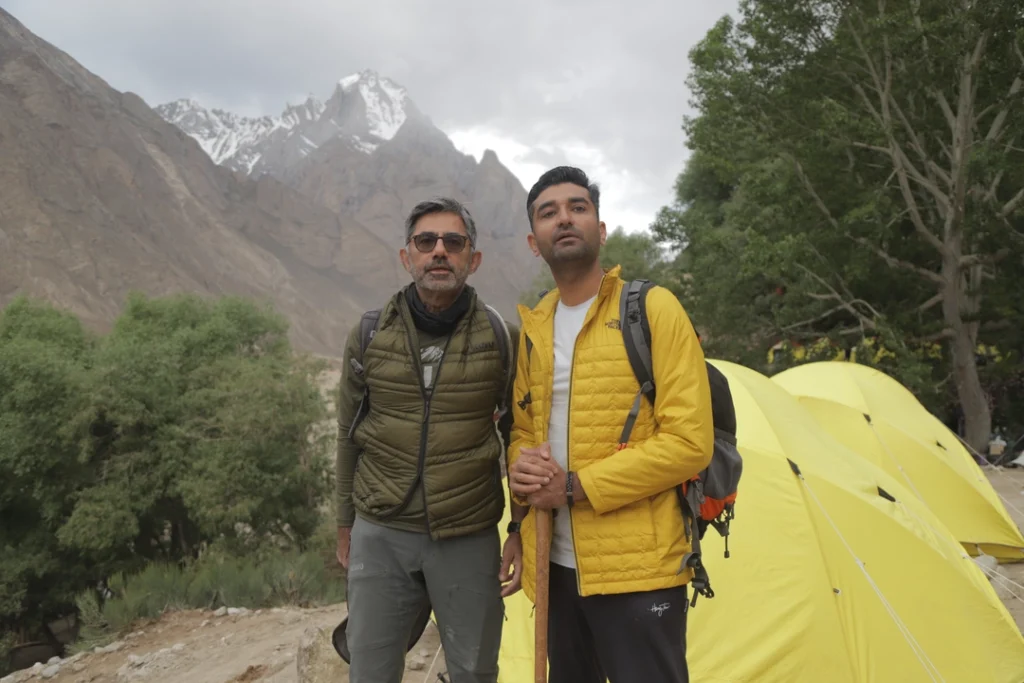
start of trekking from Pajju to Khuburse Campsite
Almost everyone in Pajju started early for Khubrse Camp, as it was a long trek. We saw various expeditions returning from Concordia with mixed stories. It took us an hour to reach the snout of Baltoro glacier. It was gigantic & site to behold.
Fast glacier water was making its way out from the mouth of Baltoro while we were ascending it. It was scary initially, but it became easier once we reached the glacier’s top. Sometimes, we had to give way to mules carrying stuff for various expeditions leading to Concordia, K2 Basecamp & Broad Peak.
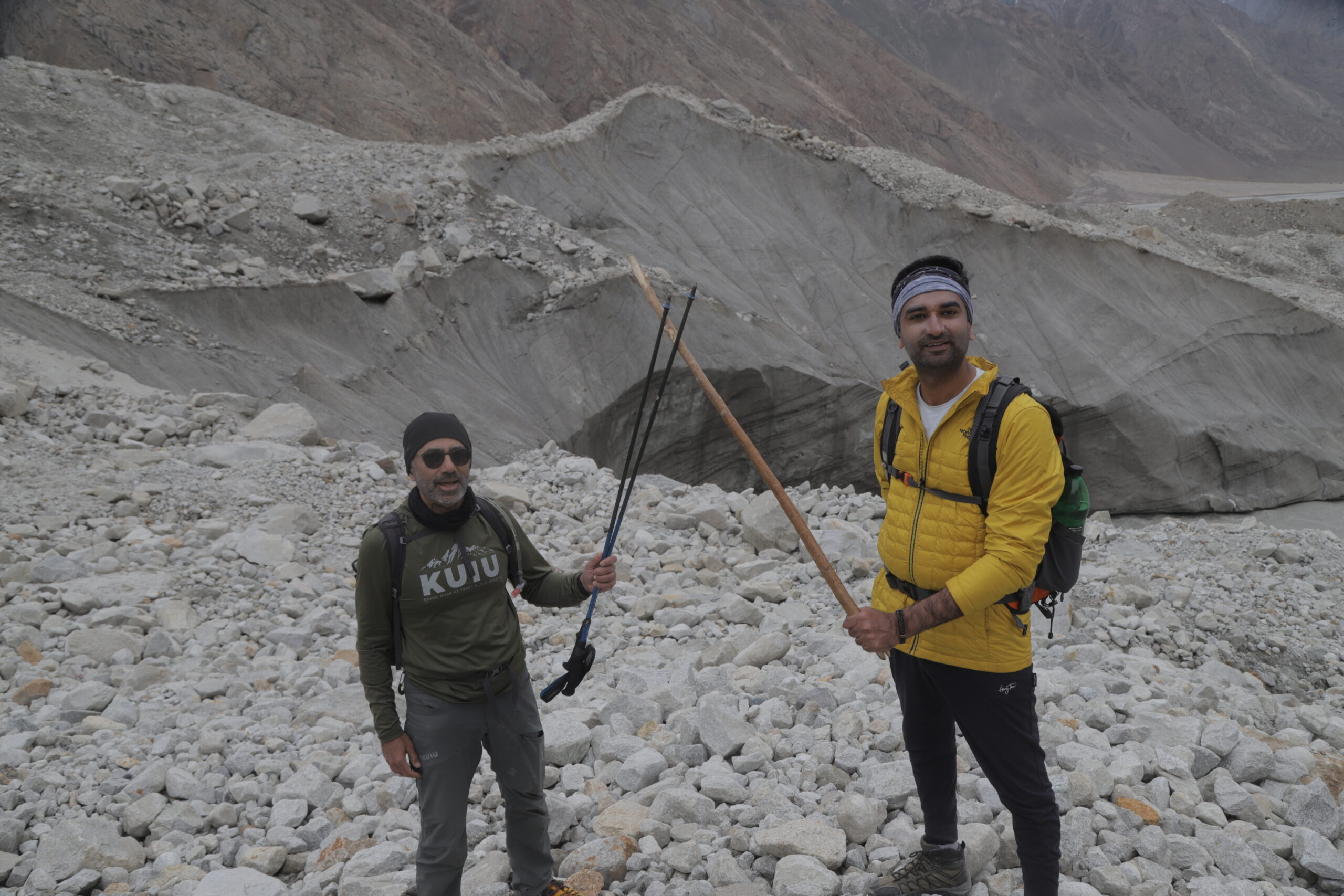
Trekking on Baltoro Glacier
Suddenly, the rain started to fall in the land of Baltoro. We had no choice but to move forward as such terrain was famous for rock falling & landslides. Eventually, after 5 Hours, we reached Liligo, where we had lunch while it was still raining.
Here we saw porters without any shades. They were unprotected from this merciless rain. The smell of food, dust & animal dung was in the air. The views were unreal. Amazingly, clouds almost touched us at that time while peaks hid their magnificence.
Today, the lunch break was brief despite the up & down journey on the glacier due to bad weather. We had to keep walking. There was no greenery and only a glacier. While walking on the glacier, we heard the sounds of ice crackling. The water was fast flowing but not visible.
It was not easy as we had to maintain our balance while the debris on the glacier was massive. We continued slowly but gradually & reached Khuburse while it was still raining. It took us 10 hours to get Pajju to Khubrse, but it seemed like an eternity that day.
Here, the campsite is even bigger than the Pajju camp. We saw more variety of camps here than any other day. Our campsite was close enough to the army post. Some personnel came to ask us a few questions and cautioned us not to film them.
Khuburse was a wide-open campsite with a bit of rock formation utilized fully for camping. Army drums dangled in the middle while tourists moved around the open-air toilet. That particular toilet had no door, just some makeshift arrangement.
While you go to the toilet, mules drop their dung outside. There were dozens of mules roaming around in all corners. The rain was relentless. As we were yet to get used to rain, it started to snow.
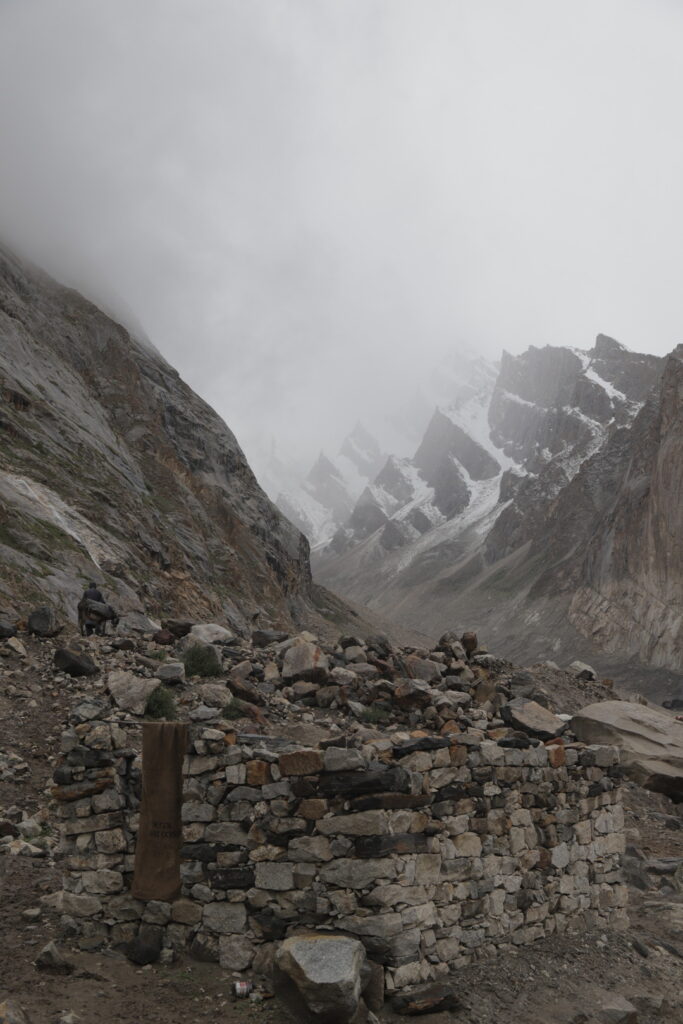
Toilet in Khuburse Campsite
It was a flurry in the first few minutes, but it picked up. While sitting in our mess tent, our kitchen looked like a better place to sit as it provided much-needed heat. We took an early dinner that day. Our chef had already slaughtered our sheep & we gleefully accepted it.
That was a cold night, and falling asleep took a great time. The snow continued from time to time. We also felt height sickness that day, but it was still bearable. Moreover, fatigue was overwhelming our body & soul. Our feet were hurting big time.
It was still cloudy the following day, but no snow had halted. Various teams decided not to proceed further same day as it was too damp & a high probability of landslide. So we have also chosen to stay in Khuburse till the weather clears.
So, as expected, snowfall started. We resorted to our kitchen, where Mehdi enlightened us with his adventures. He had been regular in the Karakoram range for the last three decades and witnessed many incidents.
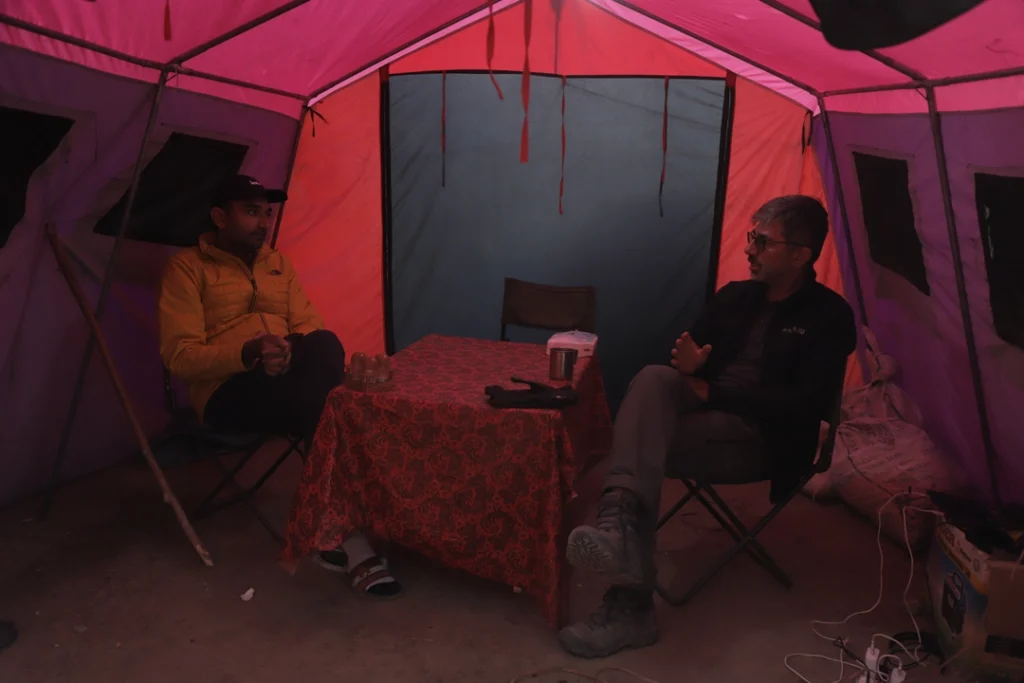
Khuburse mess tent during bad weather & snowfall
He saw people losing life in crevices at snow lake. Various avalanches block expeditions. Unwanted shuffles between porters. Furthermore, he also described how mule operators are nothing less than a mafia here. They are unprofessional and sometimes nasty as well.
Moreover, there is no organized rescue service in those mountains by the Government of Pakistan. The only hope is for those foreigners who buy international insurance policies. If any insurer gets injured, Heli rescue does come only for those with money. At the same time, poor porters have to reach Skardu using horses or mules.
While we were discussing adventurous tales, the weather was grim. The hope of trekking was almost over. We spent flocking from one camp to another where mountain lovers from Europe, the USA & various other countries were busy in their languages.
Despite bad weather, seeing tourists around the world praising might Karakoram was pleasing. Here in Khuburse, we met two high-altitude porters from Nepal. One of them had just summited “Nanga Parbat,” 2nd highest peak in Pakistan, 8126 meters in the Himalayas, Pakistan.
They did this in just mere 06 days. Next, they were aiming for G2. Nepal has come a long way. Now, they are capitalizing on the vast tourism potential of Pakistan. Almost on every single peak, including K2, We saw expeditions being led by companies in Nepal.
Here, one of the sherpas, “Tenjen Lama,” told his account of how he has been chasing a world record with “Kristin Harila” to climb all 8000 peaks in the world in record time. As you read, they have also successfully summited G1, G2, Broad peak & K2.
We also visited a nearby army camp where an officer greeted us & offered us tea. They lived in a single dark room with a concrete structure. They had the luxury of a toilet with running water. They used solar plates to consume energy that was stored in large batteries.
Life is challenging in such highlands. It remains icy in winter, and temperatures can go as low as -15 Celsius. Yet, they were highly motivated to protect their land. These brave men spend most of life in harsh environments and listen to old songs.
Sometimes, they discuss life with a group of adventurers who come from various countries. Most importantly, porters are regular in their building. They would always seek help with medicines. Few injure their toes and knees, while few claim they have soar throats. Astonishingly, we found most of the porters had some type of ailment, yet they moved around with a smile.
The next day, the weather was still cloudy but no rain or snow. We left around 3.30 am. It would be a long day; the first few minutes were extremely challenging as we ascended continuously. Our team was pushing us to make the pace.
Firstly, we reached Urudukus (3780 Meters), where we saw the most beautiful campsite of the Concordia trek. It was green, and everything looked in order. Camps were well positioned on vertical slop while toilets were sufficient as well. However, it was a bit slippery that day due to last night’s pouring.
We continued at Urudukus as we had to reach Ghoro 1. We saw the Trango Tower, considered the most famous rock climbing there. Our journey continued. Initially, we motored along the mountain on the right side, then went straight inside the heart of Baltoro and started walking on the left side.
We had our lunch midway while we sat on the ice. It was the same noodles, some dry fruit & tea. Even though we might not have liked this routine, it gave us well-needed energy. We gathered ourselves and moved forward.
From Urudukus to Ghoro 1, it is all sheer ice. It took us 13 hours to reach Ghor 1. The campsite was abuzz. People were already dancing along to porters on local songs. It was around sunset when we got Ghoro 1.
Masherbrum Peak (7821 m) was just opposite our camps. It looked unreal in golden sunlight, which was touching just its peak. That aura vanished in a few minutes, and all became cold & chilly. We then had our dinner, which was mutton karahi & mix veggies.
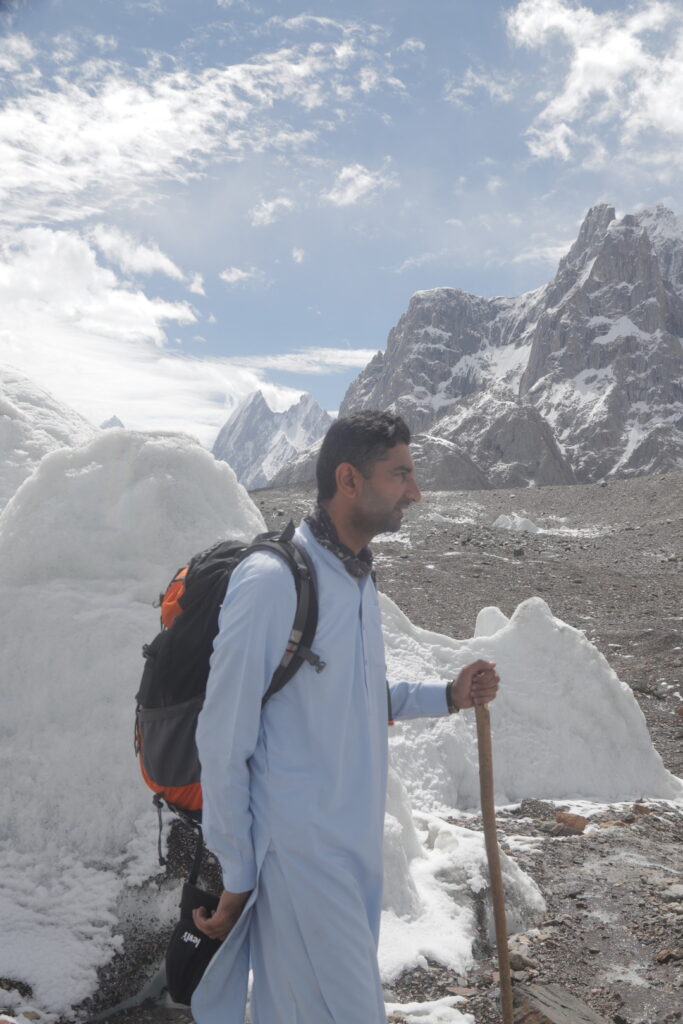
Waling on baltoro glacier
We slept on uneven icy surfaces. It was a unique but cold venture. Moreover, it was hard to breathe at 4000 meters elevation. We also experienced a severe headache that was relentless.
In the morning, we saw the place’s magnificence—lots of ice formation in different shapes with blue-white color. The peak looked even better in the morning as it was a clear sunny day. Now, K2 basecamp trek started looking more appealing
& challenging as well.
There are no toilets in Ghoro 1, so you have to go wild. It was a demanding challenge. You have to find a corner where you can relieve yourself. You had to trek to reach someplace here, yet it was still glacier all over.
We took a few photos early morning and started our trek toward Concordia, which would take 12 to 13 hours. It was a relatively cold morning. Though it was cloudy, but no rain, it was a day of reckoning as we were supposed to reach Concordia.
We then reached Ghoro 2, which had no sign of any camps that day. We did not stop there and kept a steady pace. It would be a tough day for me as I was not wearing sunglasses. While you are walking on a glacier, it is of utmost necessity to have great glasses.
I started to feel pain in my eyes. During mid-day, it began to affect me badly. Here in Concordia, always keep good shoes & glasses with you. Nobody will lend you any help. One small mistake can cost you your life.
I was not wearing the sunglasses because it got broken during the tour. Later, snow blindness started to hinder my vision. It was blurry, and the headache also started. The journey from Ghoro 1 to Concordia became among the most challenging for me.
We took lunch somewhere before Concordia & snowfall started, though it was fairly light. I put on thermals & my “Northe face” jacket that kept me from the cold wind. We were all walking heads down. Due to freezing weather, continued ascending & long journey tested our abilities.
My friend Asher Abbasi was also struggling. We asked our guide how much more it takes to reach Concordia, and he always said it’s only a matter of time. We ascended 700 meters that day from Ghoro 1 to Concordia.
The last one hour of trekking was the toughest. It was hard to breathe. Despite snow blindness & head spinning, I continued and ultimately reached Concordia & just reached the kitchen, which provided us with much-needed comfort.
We were given soup instantly as Mehdi knew what exactly we needed. It was dark & gloomy, and no sign of any peak. We were camped near Mitra Peak, and K2 Peak was supposed to be in front of our kitchen tent. Due to bad weather, we could not see anything.
I resorted to my camp and tried to rest, but my feet were damp due to broken shoes, and my eyes hurt due to snow blindness. I could not open my eyes and felt awkward. I did take dinner in a hurry and tried to sleep. At such elevation, you are unable to sleep, but I tried.
The morning was full of surprises, and I felt better than before. My team had fixed my broken sunglasses. Once I came out of my camp, I caught smiling faces around. It was a clear sunny day. We saw K2 for the very first time. Mighty K2 looked gigantic.
We saw lots of people taking photos as memory. Here weather can change in a matter of minutes. We also took a few photos in front of K2 from Concordia. We were able to see Mitra Peak from very close proximity.
The broad peak was visible, and we saw army helicopters coming in pairs. That day, we saw Heli making various flights from Skardu to Concordia. Porters & team crew were much relieved as well. There are instances when people stay in Concordia for many days, yet they cannot see K2 & other peaks.
We saw groups dancing to Balti songs. There was festivity in the air. Few foreigners were reading books. We resorted to meeting other groups. A few groups were getting ready for K2 Basecamp while a few were going to Gasherbrum 01. The journey was nothing short of extraordinary, an adventure etched forever in the depths of my heart.
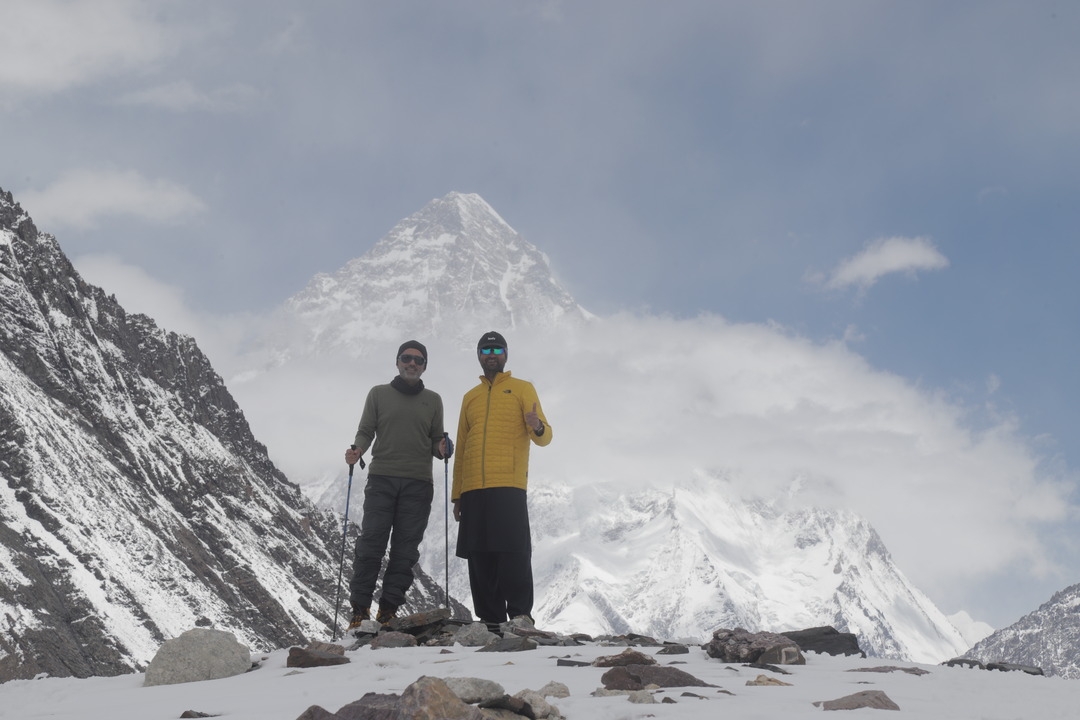
K2 CONCORDIA
The Writer, CEO & Founder of Pakistantourntravel.com is a passionate traveler with a deep love for exploring the breathtaking landscapes and hidden gems of Northern Pakistan. From the majestic mountains to the vibrant cultures, he takes great delight in immersing himself in the rich experiences and sharing captivating tales from his journeys. You can catch him as he unravels the wonders of this enchanting Pakistan and inspires fellow adventurers to embark on their own unforgettable expeditions. Connect with him @ sales@pakistantourntravel.com
12Years of relentless tourism Services in Pakistan